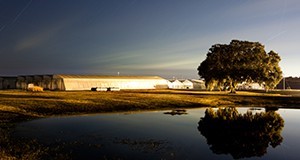Abstract
As society confronts the consequences of global warming, deteriorating water quality, and impoverished biodiversity, there is a growing urgency to develop and expand water buffers' multifunctional ecosystem services. However, limited information is available on other potential co-benefits associated with the use of buffers, particularly VFSs. This 5-page fact sheet provides information on buffers' multiple ecosystem benefits, such as niche products production, carbon sequestration, and flood risk mitigation, as well as recommendations on future research needs necessary to enhance multiple ecosystem services and benefits of buffers. Written by Lei Wu, Rafael Muñoz-Carpena, and Yuncong Li, and published by the UF Department of Soil and Water Science, November 2015.
References
Asbjornsen, H., V. Hernandez-Santana, M. Liebman, J. Bayala, J. Chen, M. Helmers, C. K. Ong, and L. A. Schulte. 2014. "Targeting perennial vegetation in agricultural landscapes for enhancing ecosystem services." Renewable Agriculture and Food Systems 29: 101-25. https://doi.org/10.1017/S1742170512000385
Ballinger, J. 2011. "Natural buffer placement and downstream flood mitigation in rural Hawke's Bay, New Zealand." Master's Thesis, Victoria University of Wellington.
Center for Subtropical Agroforestry, University of Florida. 2010. "Forest riparian buffer." http://smallfarms.ifas.ufl.edu/environment_and_recreation/forestry/pdf/cstafripbuff.pdf Accessed October 29, 2015
Cramer, W., A. Bondeau, F. I. Woodward, I. C. Prentice, R. A. Betts, V. Brovkin, and P. M. Cox. 2001. "Global response of terrestrial ecosystem structure and function to CO2 and climate change: Results from six dynamic global vegetation models." Global Change Biology 7: 357-73. https://doi.org/10.1046/j.1365-2486.2001.00383.x
Davis, A. P., W. F. Hunt, R. G. Traver, and M. Clar. 2009. "Bioretention technology: Overview of current practice and future needs." Journal of Environmental Engineering 135: 109-17. https://doi.org/10.1061/(ASCE)0733-9372(2009)135:3(109)
Deletic, A., and T. D. Fletcher. 2006. "Performance of grass filters used for stormwater treatment-A field and modelling study." Journal of Hydrology 317: 261-75. https://doi.org/10.1016/j.jhydrol.2005.05.021
Dillaha, T. A. 1989. "Vegetative filter strips for agricultural non-point source pollution control." Transactions of the American Society of Agricultural Engineers 32: 513-19. https://doi.org/10.13031/2013.31033
EPA. 2006. "Buffers and vegetative filter strips." http://water.epa.gov/type/watersheds/named/msbasin/upload/2006_8_24_msbasin_symposia_ia_session4-2.pdf. Accessed October 29, 2015
Fortier, J., B. Truax, D. Gagnon, and F. Lambert. 2015. "Biomass carbon, nitrogen and phosphorus stocks in hybrid poplar buffers, herbaceous buffers and natural woodlots in the riparian zone on agricultural land." Journal of Environmental Management 154: 333-45. https://doi.org/10.1016/j.jenvman.2015.02.039
Kimble, J. M., R. Lal, and R. F. Follett. 2002. Agricultural Practices and Policies for Carbon Sequestration in Soil. Boca Raton: CRC Press, 100-102.
Liu, W., W. Chen, and C. Peng. 2014. "Assessing the effectiveness of green infrastructures on urban flooding reduction: A community scale study." Ecological Modelling 291: 6-14. https://doi.org/10.1016/j.ecolmodel.2014.07.012
Matovic, D. 2011. "Biochar as a viable carbon sequestration option: Global and Canadian perspective." Energy 36: 2011-16. https://doi.org/10.1016/j.energy.2010.09.031
McCracken, D. I., L. J. Cole, W. Harrison, and D. Robertson. 2012. "Improving the farmland biodiversity value of riparian buffer strips: Conflicts and compromises." Journal of Environmental Quality 41: 355-63. https://doi.org/10.2134/jeq2010.0532
Muñoz-Carpena, R., J. E. Parsons, and J. W. Gilliam. 1999. "Modeling hydrology and sediment transport in vegetative filter strips." Journal of Hydrology 214: 111-29. https://doi.org/10.1016/S0022-1694(98)00272-8
Peluso, V. F., and A. Marshall. 2002. "Best management practices for south Florida urban stormwater management systems (Technical Publication Reg-044)." West Palm Beach FL: South Florida Water Management District, Everglades Stormwater Program. http://www.sfwmd.gov/portal/page/portal/xrepository/sfwmd_repository_pdf/bmp_manual.pdf Accessed October 29, 2015
Southeastern Wisconsin Regional Planning Commission. 2010. "Managing the water's edge-Making natural connections." http://www.sewrpc.org/SEWRPCFiles/Environment/RecentPublications/ManagingtheWatersEdge-brochure.pdf. Accessed October 29, 2015
South Florida Water Management District. 2002. "Best management practices for south Florida urban stormwater management systems." http://www.sfwmd.gov/portal/page/portal/xrepository/sfwmd_repository_pdf/bmp_manual.pdf Accessed October 29, 2015
USDA-NRCS. 1999. "The national conservation buffer initiative." Washington: USDA National Resources Conservation Service, 53.

